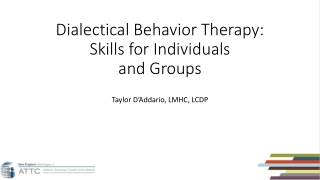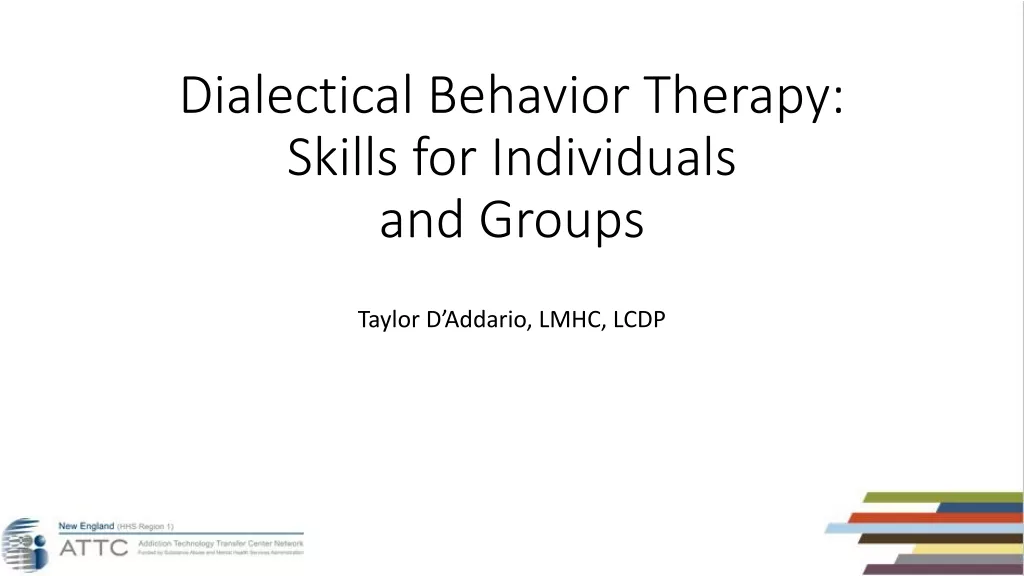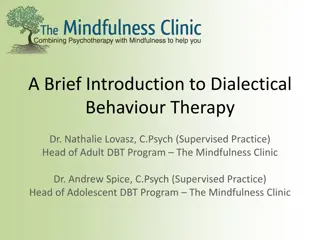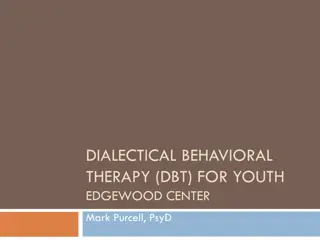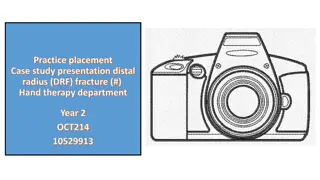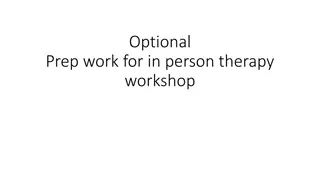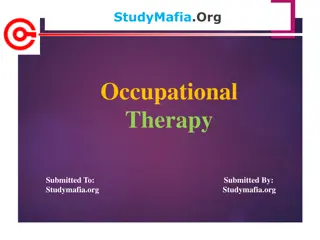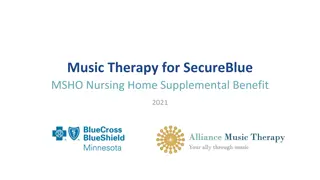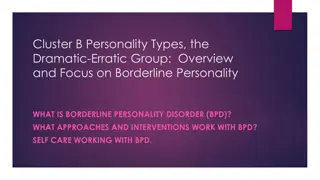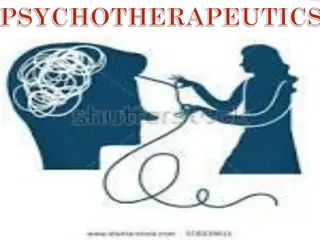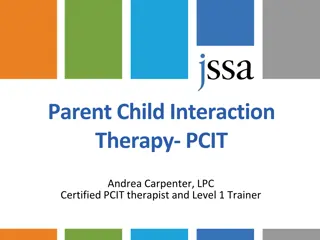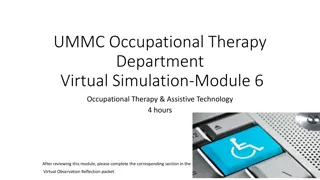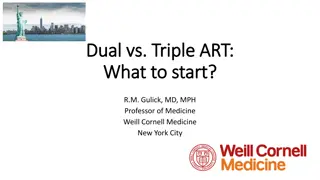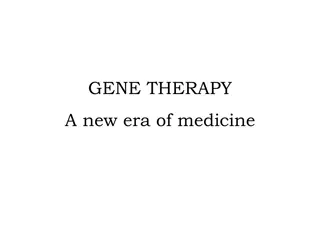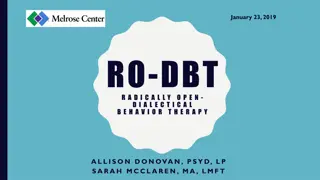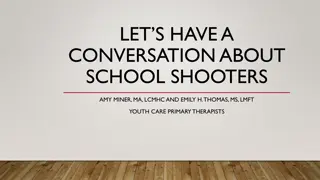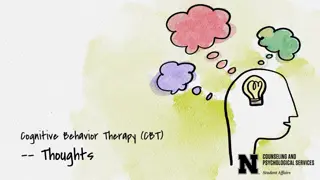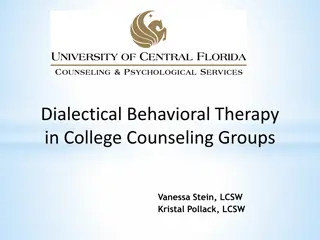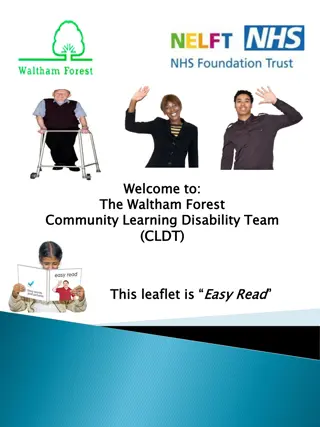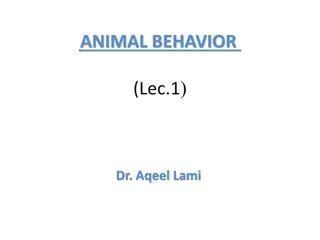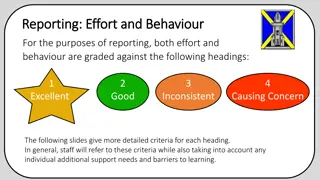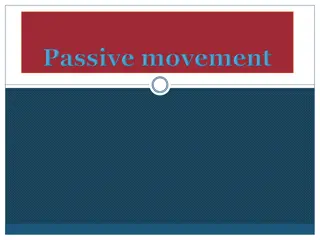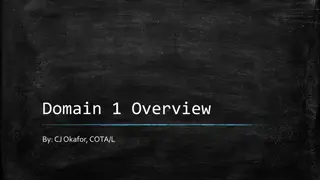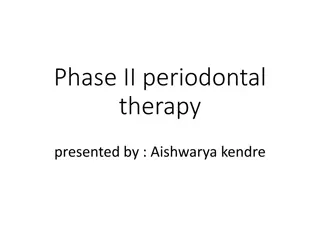Evolution of Dialectical Behavior Therapy: A Therapist's Journey
Delve into the origins of Dialectical Behavior Therapy (DBT) and the challenges faced by therapists in providing comprehensive treatment for individuals at high risk of suicide. Explore the evolution of therapist strategies blending technology of change and radical acceptance, aiming to improve motivation, enhance capabilities, and manage environmental interventions.
Uploaded on Sep 23, 2024 | 0 Views
Download Presentation

Please find below an Image/Link to download the presentation.
The content on the website is provided AS IS for your information and personal use only. It may not be sold, licensed, or shared on other websites without obtaining consent from the author. Download presentation by click this link. If you encounter any issues during the download, it is possible that the publisher has removed the file from their server.
E N D
Presentation Transcript
BRTC BRTC Behavioral Research Behavioral Research & Therapy Clinics & Therapy Clinics University of Washington University of Washington University of Washington University of Washington University of Washington University of Washington University of Washington University of Washington BRTC BRTC Behavioral Research Behavioral Research & Therapy Clinics & Therapy Clinics & Therapy Clinics & Therapy Clinics & Therapy Clinics & Therapy Clinics BRTC BRTC Behavioral Research Behavioral Research BRTC BRTC Behavioral Research Behavioral Research Center for Behavioral Technologies Development & Application of DBT: Practical Strategies for Practical Therapists Marsha M. Linehan, Ph.D., Zen Roshi
Conflicts of Interest Receives grant funding from the National Institute of Mental Health (NIMH) for DBT research and development Receives training and consultation fees from Behavioral Tech, LLC. Receives compensation as owner of Behavioral Tech Research, Inc. Receives royalties from sale of DBT books 2
Where DBT Started: 1980 Patients: high risk for SUICIDE with multiple suicide attempts/self-injuries Funding: NIMH treatment development grant for suicidal behavior Starting point: behavior therapy 3
I needed a Comprehensive Treatment that would Improve Motivation Enhance Capabilities Enhance Generalization Manage and/or Provide Environmental Intervention Maintain Skills and Motivation of Treatment Providers 5
Immediate Problems to Solve 1. Extreme sensitivity to rejection and invalidation made a change focused treatment untenable. (I m the cause?) 2. Extreme suffering made an acceptance based approach also untenable. (Aren t you going to help me?) 6
I Needed New Therapist Strategies Synthesis of: Technology of Change and Technology of ACCEPTANCE Spaciousness of Mind To dance with movement, speed and flow Radical ACCEPTANCE of: Client Slow and Episodic Rate of Progress Risk of Suicide Humility To see the transactional nature of the enterprise 7
Solution Was to Apply A Dialectical Approach Balancing Acceptance Strategies Change Strategies Dialectics 8
Modularity of DBT STRATEGIES Pay Attention Behavioral Assessment Reflect Back accurately Dialectical Strategies Contingency Management Procedures Change Strategies Acceptance Strategies Accurate reading of the unsaid Strategy Type Problem solving Core Strategies Validation Cognitive Modification Procedures Understanding the causes Irreverence Communication Reciprocally Acknowledge the inherently valid Skills Training Procedures Consultation to Patient Management of Environment Environmental Intervention With equality and Authenticity Exposure Procedures 9
Immediate Problems to Solve 3. Low distress tolerance and frequent crises and high arousal made sustained work on change very difficult. 10
I needed New Client Targets Radical ACCEPTANCE of: One set of problems to work on another set The Past, The Present Limitations on the Future Distress Tolerance: Ability to tolerate distress without impulsively moving to suicide or other destructive behavior Experience of one s own: Connection with others and the universe Essential goodness Essential validity 11
Solution Was to Develop A Dialectical Approach, Teaching Acceptance Skills Change Skills Dialectics 12
Change Skills Where they came from Social Psychology and evidence based behavior therapy interventions 13
Acceptance Skills Where they came from Contemplative prayer practices Soto Zen at Shasta Abby (California) Sanbo Kyodan Zen, combining Soto and Rinzai Zen at Benedikushof (Germany) Willigis Jaeger Benedictine Zen Master 14
Example Change Skills -Interpersonal Skills -Emotion Regulation Skills -Distress Tolerance Skills 15
Example Mindfulness Skills Wise Mind Observing Describing Participating Non-judgmentally One-mindfully Effectively Radical Acceptance Willingness Turning the Mind Mindfulness Whats Mindfulness Hows Reality Acceptance 16
Immediate Problems to Solve 4. Ever changing clinical presentation together with frequent crises resulted in confused therapists and a chaotic therapy 17
Percent DSM Diagnoses: BPD Chronically Suicidal Patients Diagnosis Lifetime Current Major depression Dysthymic disorder Substance abuse Substance dependence 56.5% PTSD Social phobia Panic disorder OCD Eating disorder 96.7% N/A 15.2% 75.0% 14.3% 5.4% 26.1% 51.1% 16.3% 40.2% 19.8% 23.9% 56.5% 21.7% 52.2% 23.9% 41.3% 18 Linehan et al., 2006
Adolescent DSM Diagnoses: Suicidal Patients Diagnosis Greater than 3 disorders Major depression Alcohol abuse Conduct disorder Substance abuse Simple phobia Social phobia PTSD Lifetime 60.6% 53.8% 43.2% 42.6% 32.9% 30.8% 28.8% 27.1% Knock & Kessler, 2006 19
Solution Was to Provide A Dialectical Balance Protocol-based Agenda Individualized Target- based Agenda Dialectics 20
Immediate Problems to Solve 5.Need for multiple interventions and a host of behavioral skills could easily lead to memory overload and confusion about what to do when. 21
A Hierarchical Approach Higher Importance Higher Importance Life Threatening Behaviors 1: Behavior Dyscontrol Therapy Interfering Behaviors 2: Quiet Desperation (Serious) Quality of Life Interfering Behaviors 3: Problems in Living 4: Incompleteness Skills Deficits Lower Importance Lower Importance 22
The Immediate Problem to Solve 6. Treating individuals at chronic high suicide risk is scary, often leads to treatment based on fear of being sued and often leads to burnout. Standard of care has no data that it is effective. (Hospitalization has no data that it reduces suicide) There was no evidence-based treatment to fall back on. 23
Solution Was to Provide A Dialectical Balance DBT Risk Assessment and Management Protocol Standard of Care Dialectics 24
Linehan Suicide Safety Net (LSSN) based on the DBT Risk Assessment and Management Protocol ( LRAMP ) 25
The Problem Further 7. Therapist emotion dysregulation often led to excessive fear, anger and hostility resulting in attempts to control the patient, rejection and burnout. 8. Excessive empathy leading to falling into the pool of despair with the client and abandoning therapy 26
Solution Was to Provide A Dialectical Balance Client Therapist Team 27
DBT Staff Hierarchy Client Individual Therapist/ Case Manager Case Manager Skills Trainer(s) Team Leader Medication Prescriber 28
Next Problem to Solve 9. Getting an NIMH grant required at least one mental disorder as an inclusion criteria My choices were BPD or Depression as both were related to suicide I chose BPD 29
Solution Was to Provide A Dialectical Balance Diagnosis Problem Behavior Mechanisms of Disorder 30
Next Problem to Solve 10. Develop a model of BPD Capable of guiding effective therapy Non-pejorative, engendering compassion Compatible with current research data 31
BPD is a Pervasive Disorder of the Emotion Regulation System BPD criterion behaviors function to regulate emotions or are a natural consequence of emotion dysregulation 32
Solution Further Was to Provide A Dialectical Model of Pathogenesis Biological Regulation Disorder Invalidating Social Environment Transaction 33
Next Problem to Solve 11. Does DBT Only Work only because the Linehan is an expert therapists ? 34
DBT compared to Expert Community Therapy Suicide attempts: 50% ER visits for suicidality: 53% Inpt. admits for suicidality: 73% All remain 50% lower during follow-up 35
Does DBT Only Treat BPD? Data indicated it was useful for other disorders but Stigma of DBT kept people out of DBT 36
Examples DBT for Substance Abuse DBT for Heroin Addiction DBT for Adolescents DBT for Native Americans DBT for Friends and Families 37
Outcomes for Axis I Disorders: 87% 68% 64% 47% 39% 35% 38 (Harned, Chapman, Dexter-Mazza, Murray, Comtois, & Linehan, 2008)
Next Problem to Solve 12. Standard DBT is very good at treating disorders with out-of-control behaviors DBT anxiety disorder outcomes were not as good as behavioral treatments treating anxiety disorders in standard practice 39
Next problem further 13. High risk individuals are sometimes not able to tolerate the stress of exposure-based treatments I had scared many out of providing exposure treat by pointing this out. 40
Solution Was to Combine DBT Prolonged Exposure Protocol DBT Contingency Management EB DBT Melanie Harned 41
Do Clients use skills? (Neacsiu, Rizvi, & Linehan, 2010) 43
Do Skills Effect Outcomes Use of DBT skillful behaviors partially accounts for reductions in difficulties in emotion regulation. Improved interpersonal relationships Reduction in suicidal behaviors Skills alone given to waiting list for DBT Reduce suicide attemptsShelly McMain 44
Next Problem to Solve 14. Patient populations differ due to differential diagnosis and problems, differential context and environment and also due to different cultures 46
Solution Was to Stretch DBT without Changing it to non-DBT Modify Only Where Absolutely Necessary Keep Everything Else EB DBT 47
Solution is to Increase DBT Research: BPD/High Risk Individual + Skills Axis I/Low Risk Skills Training Alone EB DBT 48
Suicidal & Intentional Self-injurious Acts By Condition and Time Mean # of Acts (Linehan et al., 1991, 1999, 2002, 2006) 52
Is DBT cost effective? Cost for DBT is approximately 50% LOWER than treatment as usual DBT also has significantly FEWER: Inpatient days Deliberate self-injury Emergency medical visits Therapy drop out 53
Is DBT cost effective? Yes! 54


